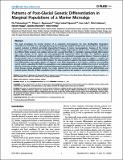Por favor, use este identificador para citar o enlazar a este item:
http://hdl.handle.net/10261/323623COMPARTIR / EXPORTAR:
 SHARE SHARE
 CORE
BASE CORE
BASE
|
|
| Visualizar otros formatos: MARC | Dublin Core | RDF | ORE | MODS | METS | DIDL | DATACITE | |

| Título: | Patterns of post-glacial genetic differentiation in marginal populations of a marine micro-alga |
Autor: | Tahvanainen, Pia; Alpermann, T.J.; Figueroa, Rosa Isabel CSIC ORCID; Uwe, J.; Hakanen, P.; Nagai, Shatoshi; Blomster, J.; Kremp, A. | Palabras clave: | AFLP Centro Oceanográfico de Vigo Medio Marino Alexandrium ostenfeldii Genetic structure |
Fecha de publicación: | 2012 | Citación: | PlosOne, 7(12). 2012: e53602(1)-e53602(12) | Resumen: | This study investigates the genetic structure of an eukaryotic microorganism, the toxic dinoflagellate Alexandrium ostenfeldii, from the Baltic Sea, a geologically young and ecologically marginal brackish water estuary which is predicted to support evolution of distinct, genetically impoverished lineages of marine macroorganisms. Analyses of the internal transcribed spacer (ITS) sequences and Amplified Fragment Length Polymorphism (AFLP) of 84 A. ostenfeldii isolates from five different Baltic locations and multiple external sites revealed that Baltic A. ostenfeldii is phylogenetically differentiated from other lineages of the species and micro-geographically fragmented within the Baltic Sea. Significant genetic differentiation (FST) between northern and southern locations was correlated to geographical distance. However, instead of discrete genetic units or continuous genetic differentiation, the analysis of population structure suggests a complex and partially hierarchic pattern of genetic differentiation. The observed pattern suggests that initial colonization was followed by local differentiation and varying degrees of dispersal, most likely depending on local habitat conditions and prevailing current systems separating the Baltic Sea populations. Local subpopulations generally exhibited low levels of overall gene diversity. Association analysis suggests predominately asexual reproduction most likely accompanied by frequency shifts of clonal lineages during planktonic growth. Our results indicate that the general pattern of genetic differentiation and reduced genetic diversity of Baltic populations found in large organisms also applies to microscopic eukaryotic organisms. | URI: | http://hdl.handle.net/10261/323623 | DOI: | 10.1371/journal.pone.0053602 |
| Aparece en las colecciones: | (IEO) Artículos |
Ficheros en este ítem:
| Fichero | Descripción | Tamaño | Formato | |
|---|---|---|---|---|
| 30_Tahvanainen_et_al_2012.pdf | Tahvanainen et al. 2012 | 904,2 kB | Adobe PDF |  Visualizar/Abrir |
CORE Recommender
PubMed Central
Citations
14
checked on 28-abr-2024
SCOPUSTM
Citations
50
checked on 18-may-2024
WEB OF SCIENCETM
Citations
47
checked on 27-feb-2024
Page view(s)
11
checked on 22-may-2024
Download(s)
7
checked on 22-may-2024
Google ScholarTM
Check
Altmetric
Altmetric
Artículos relacionados:
NOTA: Los ítems de Digital.CSIC están protegidos por copyright, con todos los derechos reservados, a menos que se indique lo contrario.
